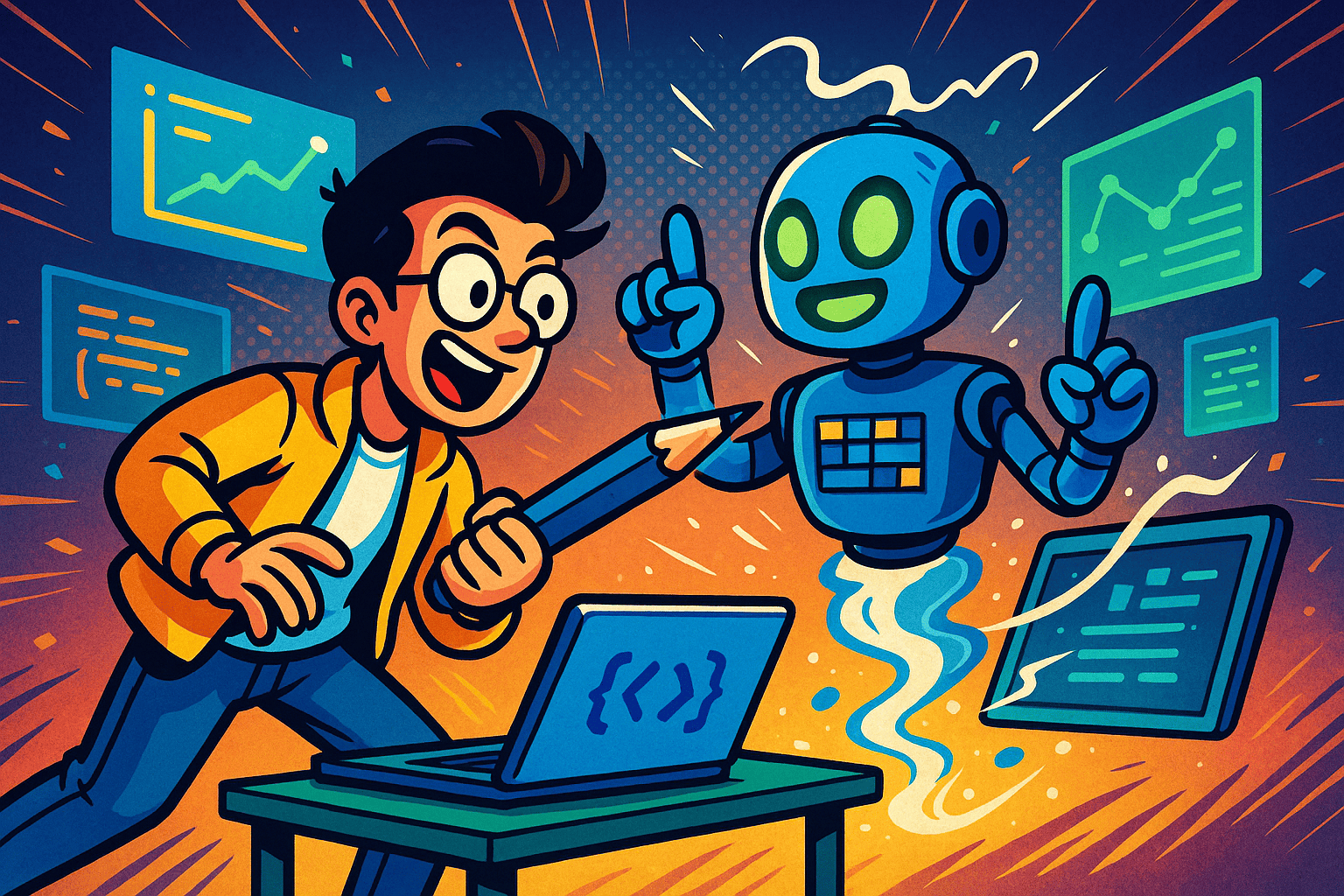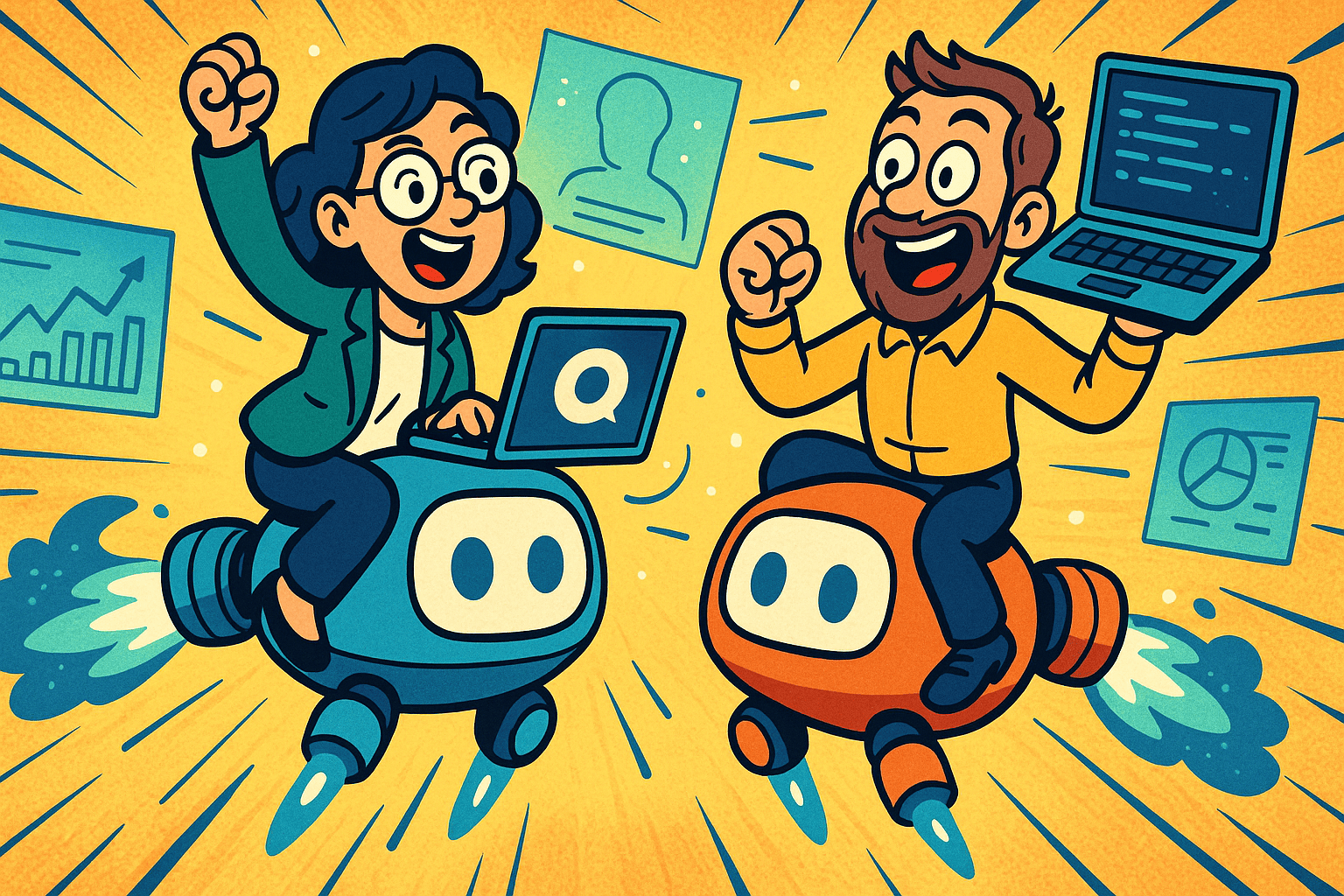💡 Quick Takeaway: if you need to launch reliable AI features quickly, choose Python for most teams and workflows. Keep an off-ramp for performance-critical parts (e.g., inference engines, robotics control loops) in C++ or Rust, and integrate with your existing stack (Java, .NET, Go, JS/TS) for enterprise-grade services and scale.
▶️ If you’re a founder or an executive, you’re not buying a programming language, you’re buying time for value and confidence.
The wrong language decision can turn a promising AI initiative into a year of rewrite work. The right decision, paired with a disciplined delivery approach, lets you ship features in weeks, validate with customers, and then harden the parts that matter.
This article answers the question “What’s the best programming language for AI?” with a business reality check: most teams prototype in Python, then deploy production services in the language that fits their platform, and move latency-sensitive operations to C++/Rust or to optimized runtimes (ONNX Runtime, TensorRT, TVM) when it’s worth the engineering effort.
That’s the path we use at Bitbytes to de-risk delivery and keep options open as your product scales.
👉 Quick next step: Looking for a plan you can share with your board or investors? Contact us for an architecture and build plan custom to your industry and compliance needs.
Table of Contents
What “Best” Really Means for AI in Business
“Best” is contextual. For AI projects, Bitbytes evaluates language choices across six business-critical dimensions:
- Time-to-Value — How fast can a small team go from idea → working feature → user feedback?
- Total Cost of Ownership (TCO) — Dev velocity, staffing availability, infra cost, and maintenance complexity.
- Performance & Latency — P95/P99 response times, on-device constraints, streaming workloads.
- Security & Compliance — Static analysis, SBOM, dependency governance, data residency, auditability.
- Ecosystem & Talent Pool — Libraries, community support, hiring market depth.
- Integration Surface — Fit with existing microservices, observability, and deployment processes.
This lens leads to pragmatic stack choices, not dogma. You ship value quickly, and you don’t lock yourself out of future optimization.
Languages for AI — What to Choose, Why It Matters, and How Bitbytes Uses Each
Choosing a language isn’t about fan clubs “it’s about time-to-value today and room to optimize tomorrow”.
Below is a practical, business-first deep dive into the major options. For each language you’ll see: where it fits, strengths, trade-offs, and how we typically deploy it in real products.
| Language | Best fit | Primary frameworks / runtimes | Watch-outs & Bitbytes guidance |
|---|---|---|---|
| Python | Most ML/AI work; fast discovery & iteration | PyTorch, TensorFlow, scikit-learn, JAX, Hugging Face, ONNX | Runtime is slower; keep Python for training/experiments, then export to ONNX/TorchScript and serve hot paths in C++/Rust or optimized runtimes (TensorRT/ONNX Runtime). |
| C++ | Ultra-low latency inference, robotics, custom kernels | ONNX Runtime, TensorRT, custom CUDA/cuDNN | Highest performance, highest complexity. Use for critical inference lanes only; keep app logic elsewhere. Plan for longer dev cycles and strict CI. |
| Rust | Safe high-perf services and edge devices | tch-rs, burn, ONNX Runtime, TVM | Memory safety + speed ideal for edge and long-running services. Ecosystem smaller; budget ramp-up time. Great for predictable footprint and reliability. |
| Java / Kotlin | Enterprise AI backends on JVM | DJL, ONNX Runtime, Spring/Micronaut | Excellent for platform-aligned serving with strong ops, SSO, and governance. Keep model training in Python; export models and host on JVM for consistency. |
| C# / .NET | Windows-first & Microsoft-centric orgs | ML.NET, ONNX Runtime, ASP.NET | Great tooling and enterprise fit. Similar guidance as JVM: train in Python, serve on .NET where the platform & teams already excel. |
| Go | Scalable AI gateways, data pipes, microservices | ONNX Runtime, gRPC, gomlx (emerging) | Superb for concurrency and simple deploys. Use as model gateway or service glue; do training/experimentation elsewhere. |
| JavaScript / TypeScript | Browser/web AI, interactive demos & UX | TensorFlow.js, ONNX Runtime Web, WebGPU | Perfect for demos and UX; production models typically run server-side (Python/Go/Java) for cost & reliability. |
| Swift / Kotlin (mobile) | On-device iOS/Android inference | Core ML, TFLite, ML Kit, NNAPI | Mostly inference; training remains server-side. Convert from PyTorch/TF → Core ML/TFLite. Great for privacy, offline and low latency UX. |
| R | Statistics, classical ML, reporting/BI | tidymodels, caret, xgboost, Shiny | Ideal for analytics teams; less suited to deep learning at scale. Integrate with Python/serving stacks for production. |
| Julia | Scientific computing, research prototypes | Flux, Zygote, DifferentialEquations | High-level yet fast, but smaller community. Strong for research; plan integration bridges to mainstream serving stacks. |
1. Python — Default for Discovery, Research, and Fast Iteration
Why teams pick it: Python has the richest ML ecosystem and the shortest path from idea to working feature.
Where it shines
- Prototyping and experiments (weeks, not months).
- Training pipelines with PyTorch, TensorFlow, scikit-learn, JAX.
- Data work (NumPy, Pandas, Polars), feature engineering, evaluation.
Trade-offs
- Slower runtime than compiled languages.
- GIL and multi-threading quirks for CPU-heavy concurrent tasks.
Bitbytes guidance
- Start in Python for velocity and learning.
- Export trained models using ONNX or TorchScript.
- Serve in Python if latency budgets allow; otherwise off-ramp hot paths to C++/Rust or an optimized runtime (ONNX Runtime, TensorRT, TVM).
▶️ Good fit for: MVPs, model training, analytics-heavy products, teams hiring generalist engineers.
2. C++ — Performance Ceiling and Custom Kernels
Why teams pick it: When P95 latency and throughput dominate the business case, C++ gives you fine-grained control.
Where it shines
- High-throughput inference (CPU/GPU), TensorRT engines, custom CUDA ops.
- Robotics/control loops, AR/VR rendering + AI blends.
- Memory-sensitive, low-latency microservices.
Trade-offs
- Longer dev cycles; higher complexity.
- Narrower hiring pool than Python/JS/Java.
Bitbytes guidance
- Use C++ for the inference lane only, not your entire product.
- Keep business logic and experimentation in Python or your platform language.
- Wrap with clear gRPC/HTTP contracts and CI that runs perf tests on every PR.
▶️ Good fit for: Real-time UX, voice/video, robotics, cost-sensitive inference at scale.
3. Rust — Memory Safety with Speed (Great at the Edge)
Why teams pick it: C-like performance with strong safety guarantees; predictable footprint on constrained devices.
Where it shines
- Edge devices and gateways, long-running services.
- High-concurrency servers with tight memory control.
- Safe FFI to C/C++ libraries; bindings like tch-rs, burn, ONNX Runtime.
Trade-offs
- Smaller AI ecosystem than Python/C++.
- Learning curve for teams new to ownership/borrowing.
Bitbytes guidance
- Choose Rust for reliability and footprint, especially offline/edge scenarios.
- Train in Python, export, and run via ONNX Runtime in Rust.
- Bake in signed updates, offline logs, and delayed telemetry.
▶️ Good fit for: Industrial IoT, on-device inference, safety-critical workloads.
4. Java / Kotlin — Enterprise AI that Fits Your JVM Platform
Why teams pick it: Operational maturity, tooling, and seamless fit with existing JVM microservices.
Where it shines
- Stable, policy-friendly serving of exported models via DJL + ONNX Runtime.
- Large-scale APIs with SSO, quotas, tracing, and org-wide governance.
- Teams already standardized on Spring/Micronaut.
Trade-offs
- Research iteration is slower than Python.
- Fewer cutting-edge training frameworks.
Bitbytes guidance
- Keep training in Python, serve on JVM for platform harmony.
- Use gRPC contracts, centralized logging/metrics, and SLOs.
- Great for multi-team orgs that require strict change control.
▶️ Good fit for: Enterprises with JVM standards, regulated environments, multi-region backends.
5. C# / .NET — Microsoft-first Stacks, Strong Tooling
Why teams pick it: Smooth integration with Windows, Azure, and existing .NET services.
Where it shines
- ML.NET for classical tasks; ONNX Runtime for deep learning inference.
- API services with ASP.NET, AD/Entra ID integration, enterprise observability.
Trade-offs
- Research ecosystem smaller than Python’s.
- Community examples skew enterprise, not bleeding-edge.
Bitbytes guidance
- Train in Python; export to ONNX; host inference in .NET where it meshes with ops and identity.
- Use gRPC/REST gateways and autoscaling policies tuned to P95/P99.
▶️ Good fit for: .NET shops, Windows-heavy fleets, Azure-centric enterprises.
6. Go — Simple, Scalable AI Services and Gateways
Why teams pick it: Deployment simplicity, tiny images, great concurrency—ideal for glue and gateways.
Where it shines
- Model gateways, data pipelines, event-driven systems.
- Cost-efficient horizontal scale with minimal ops friction.
Trade-offs
- Emerging training frameworks (e.g., gomlx) still maturing.
- Not the best place to do heavy research.
Bitbytes guidance
- Use Go for serving, routing, and orchestration around models trained elsewhere.
- Keep images small, configs explicit, and timeouts sane.
- Integrate ONNX Runtime or call out to specialized inference services.
▶️ Good fit for: Cloud-native shops, platform teams, API aggregation layers.
7. JavaScript / TypeScript — Web UX, Demos, and Browser Inference
Why teams pick it: Immediate reach; AI running in the browser for interactive experiences.
Where it shines
- Prototyping UX with TensorFlow.js, ONNX Runtime Web, WebGPU.
- Privacy-preserving, on-device inference for small/medium models.
- Full-stack teams are already comfortable with Node/React.
Trade-offs
- Client hardware limits throughput/model size.
- Production economics usually favor server-side inference.
Bitbytes guidance
- Use JS/TS for UX and demos, then serve models server-side (Python/Go/Java) at scale.
- Consider streaming outputs to keep the interface snappy.
▶️ Good fit for: Product-led growth demos, interactive UIs, privacy-first features.
8. Swift (iOS) / Kotlin (Android) — on-Device Mobile AI
Why teams pick it: Tight OS integration and low-latency on-device experiences.
Where it shines
- Conversions from PyTorch/TF to Core ML or TFLite.
- Offline inference, privacy by default, AR + vision tasks.
Trade-offs
- Mostly inference; training remains server-side.
- Model sizes/ops constrained by device hardware.
Bitbytes guidance
- Keep training in Python; convert to Core ML/TFLite with quantization.
- Use NNAPI/Metal acceleration; ship signed models with versioning.
- Profile P95/P99 latency on real devices—not simulators.
▶️ Good fit for: Consumer apps, field tools, privacy-sensitive workloads.
9. R — Statistics, BI, and Explainable Analysis
Why teams pick it: A first-class environment for statistical modeling and reporting.
Where it shines
- Classical ML, time series, AB testing, BI dashboards (Shiny).
- Analysts who need rigor and clear explainability.
Trade-offs
- Less suited to large-scale deep learning and modern MLOps.
- Smaller pool for production engineering.
Bitbytes guidance
- Use R where statistical depth matters; integrate outputs with Python training or JVM/.NET serving.
- Keep production inference in stacks with stronger ops support.
▶️ Good fit for: Analytics teams, BI-heavy orgs, experimentation platforms.
10. Julia — Scientific Computing with Speed
Why teams pick it: Research-friendly syntax that can hit C-like speeds.
Where it shines
- Scientific ML, differential equations, numeric computing (Flux, Zygote).
- Academic or R&D teams who value elegant math-first code.
Trade-offs
- Smaller ecosystem and hiring pool.
- Integration gaps for enterprise ops remain.
Bitbytes guidance
- Great in research loops; package results for serving in mainstream stacks.
- Plan bridges (ONNX, REST/gRPC) early to avoid operational bottlenecks.
▶️ Good fit for: Research labs, scientific modeling, simulation-heavy products.
How We Combine Languages Without Regrets
✅ Prototype fast, then export: Train in Python → ONNX/TorchScript → serve in C++/Rust/Go/Java/.NET when warranted.
✅ Keep boundaries clean: Model = artifact; service = contract. Swap either without rewriting everything.
✅ Instrument everything: P50/P95/P99, cost/request, drift metrics; let data—not preference—decide when to optimize.
✅ Match the platform: If your org is JVM/.NET/Go-centric, keep serving there for SSO, governance, and observability.
▶️ Need a stack recommendation mapped to your KPIs and latency budget? Contact Us for a quick, defensible plan or Explore Case Studies to see these patterns in the wild.
How Bitbytes Builds Trust — Expertise, Methodology, and Proof
▶️ Proven Playbooks: We’ve repeatedly delivered AI features using the prototype-in-Python, serve-where-it-fits approach. It shrinks time-to-market and reduces rewrite risk.
▶️ Security by Design: SBOM, pinned dependencies, secret management, and audit trails from sprint one; we build for regulated industries without slowing velocity.
▶️ Performance with Discipline: Quantization, batching, graph compilers, and GPU/accelerator targets are standard tools—not afterthoughts.
▶️ Transparent Delivery: Milestone-driven plans, demo-every-sprint, and metrics that tie directly to business outcomes (activation, retention, cost/request).
▶️ Long-Term Partnership: We don’t just ship v1—we help you operate, improve, and plan the next quarter’s roadmap with eyes on cost, risk, and growth.
Ready to move from talk to traction? Contact Us to start your build plan.
Why the Language Choice Is a Product Decision (Not Just Technical)
1) Time-to-Market vs. Performance (Choose When to Optimize)
Python delivers rapid iteration and rich libraries, which matter most in the discovery → validation phase. When usage grows and latency or cost becomes painful, we optimize the bottlenecks—not the whole product. That often means:
- Exporting models to ONNX or TorchScript.
- Serving inference via C++ or Rust services, or accelerated runtimes (TensorRT, ONNX Runtime, TVM).
- Keeping Python for training & experimentation, where its productivity shines.
You get speed now and performance later without a rewrite.
2) Hiring & Maintainability (Your Stack Is a Recruiting Strategy)
Python and JavaScript expand your hiring funnel; C++/Rust narrow it but can yield long-term performance and safety wins.
Java/.NET/Go are great for service stability and ops discipline. We advise clients to pick a two-language strategy: the language for learning fast and the language for serving at scale.
3) Security, Compliance & Auditability (You Can’t Bolt It On)
Your language choice affects how you manage supply-chain risk (SBOM), secrets, static analysis, license compliance, and audit trails.
Regulated industries (healthcare, finance, gov) benefit from ecosystems with strong policy enforcement, observability, and change control. Bitbytes bakes these into the architecture from sprint one.
▶️ Need an architecture you can defend to security and finance? Talk to Bitbytes—we’ll map controls to your stack and sprint plan.
The Bitbytes Methodology — De-Risked, Outcome-Focused
We build AI products to learn quickly, ship confidently, and scale safely. Each phase has a clear purpose, lightweight artifacts, and guardrails so you can move fast without breaking trust.
1) Discovery & Feasibility — Align Intent with Reality
Before a single sprint, we turn business intent into an executable plan you can defend to leadership.
- What we lock in: goals, KPIs, data sources, constraints (budget, timelines, compliance).
- What we stress-test first: data quality, model feasibility, and critical UX.
- How we govern: a named owner, decision cadence, and a short, prioritized backlog.
Outcome: a credible plan that reduces uncertainty—no open-ended “research projects.”
2) Architecture & Stack Decision — Choose once, Scale Often
We design for speed now and performance + compliance later, so you won’t face rewrites.
- Guiding constraints: target P95/P99 latency, throughput, TCO, security and regulatory needs.
- Default pattern: Python-first for training/experiments, with a performance off-ramp to C++/Rust/Go for hot paths.
- Fit to your platform: clean integration points for JVM/.NET/Node/Go, plus SSO, logging, and policy.
Outcome: diagrams, SLOs, data contracts, and a deployment plan tied to KPIs.
3) Prototype → Proof — Ship Value as Thin Vertical Slices
We put working software in users’ hands early to validate value, cost, and usability.
- How we slice: Data → Model → API → UI (one “walking skeleton” at a time).
- Lock-in avoidance: package models with ONNX/TorchScript to keep serving options open.
- Instrument from day one:
- Quality: precision/recall, hallucination rate, human-in-the-loop signals.
- Cost & perf: cost/request, P50/P95/P99, GPU/CPU utilization.
- Safety: content filters, rate limits, abuse telemetry.
Outcome: a proof that satisfies both end users and CFOs.
4) Production Hardening — Make Reliability Boring
When the idea works, we make it safe, observable, and repeatable.
- Reliability: CI/CD, unit/integration/E2E, adversarial tests, canary + blue/green deploys, drift detection.
- Security: SBOM and pinned deps, secret rotation, least-privilege IAM, audit logs, PII controls.
- Performance: quantization, batching, graph compilers, GPU/accelerator targets, right-sized autoscaling.
Outcome: predictable releases, stable latency, and a security story auditors approve.
5) Operate & Improve — Own the Outcome
Post-launch, we keep quality high and costs in check while you keep shipping.
- Continuous improvement: human-in-the-loop review, prompt/model versioning, shadow/A-B tests.
- Cost governance: dashboards for unit economics; monthly P95/P99 and error-budget reviews.
- Strategic evolution: quarterly roadmap for refactors, language transitions, and infra shifts.
Outcome: a product that gets measurably better every quarter.
Case Studies & Examples — What Works in the Wild
We often work under strict NDAs. The snapshots below are anonymized, but they accurately reflect the kinds of outcomes we deliver.
Each one shows a familiar pattern: prototype fast where learning matters, harden where performance and governance matter, and keep the integration surface clean so you can evolve the stack without drama.
Case A — B2B SaaS: Python → C++ Off-Ramp for Latency
Context:A B2B SaaS platform needed AI suggestions inside a high-traffic customer workflow. Early builds in Python moved quickly but struggled to hold P95 < 120 ms under peak load. The business wanted speed and a smooth user experience, no regressions, no rewrites.
Approach (thin slices, then optimize):
- Prototype and validate in Python (PyTorch) to ship value fast.
- Export the model to ONNX to decouple training from serving.
- Stand up a slim C++ inference service using ONNX Runtime + TensorRT on GPU nodes.
- Batch/bundle requests at the gateway to keep p95/p99 predictable.
Outcome (what changed, what didn’t):
- Feature shipped in 6 weeks with Python.
- Off-ramp cut median latency by 45–60%—without changing the UX or the data contracts.
- The product team kept full velocity on experiments while the platform team tuned the inference lane.
Takeaway:💡 Start where you learn fastest; optimize only where it pays off. Your customers feel the snappy UX, not the language debate.
Case B — Edge AI: Rust for Stability and Footprint
Context:An industrial IoT fleet needed on-device image analysis. Constraints were tight: limited memory, intermittent connectivity, and a demand for predictable behavior across thousands of devices.
Approach (safety and control at the edge):
- Build Rust microservices on the device for memory safety and stable performance.
- Keep training in Python; export models and run with ONNX Runtime, enabling device-specific acceleration.
- Ship signed updates, maintain offline logging, and delay telemetry uploads to handle patchy networks.
Outcome (operational calm):
- Stable memory profiles and far fewer crash loops.
- Simpler updates and auditable binaries across the fleet.
- Edge workloads became predictable, ops could plan instead of firefight.
Takeaway:💡 Rust shines when reliability and footprint beat raw iteration speed. You get consistent behavior in hostile environments.
Case C — Enterprise Analytics: JVM for Operational Maturity
Context: A global enterprise needed AI scoring inside existing JVM microservices. Requirements included SSO, centralized logging, change control, and adherence to platform standards. Research velocity mattered, but governance mattered more.
Approach (meet the platform where it lives):
- Keep model development in Python for speed and library breadth.
- Export to ONNX, then host inference in a Java service using DJL + ONNX Runtime.
- Expose gRPC endpoints; apply org-wide policies for auth, quotas, tracing, and SLAs.
Outcome (no surprises for security or ops):
- Clean integration with platform standards, no special exceptions.
- Easy rollout via existing CI/CD and observability stacks.
- Product teams moved faster because the platform team stayed confident.
Takeaway:💡 Match the serving language to your platform, even if training stays in Python. You win on compliance, support, and long-term maintainability.
Architect’s Playbook — Quick Checks Before You Commit
A short, practical checklist to validate language and architecture decisions.
- Latency budget: define P95/P99 targets and test on real devices and networks.
- Throughput & cost: requests/min, GPU/CPU mix, autoscaling rules, quotas.
- Data & model lifecycle: lab → staging → prod; version datasets/models/prompts.
- Security & compliance: SBOM, vuln scanning, secrets, PII handling, audit trails.
- Observability: traces, metrics, structured logs; red/black-box drift monitors.
- Hiring & ramp-up: skills you can hire this quarter; training plan for gaps.
- Exit strategy: swap models/runtimes without rewrites (use ONNX/TorchScript).
Governance: rollback and kill-switches; human override for safety-critical flows.
Frequently Asked Questions
Python, because it has the broadest ML ecosystem (PyTorch, TensorFlow, scikit-learn, JAX), the richest tutorials, and the largest hiring pool.
C++ is better when you need ultra-low latency, tight memory control, or custom kernels. Python is better for rapid experimentation and ecosystem breadth. Many teams prototype in Python and serve hot paths with C++ or accelerated runtimes.
Python. Start with scikit-learn and PyTorch. When latency or cost requires it, export models (ONNX/TorchScript) and serve them in a faster microservice without changing your product’s UX.
Use JavaScript/TypeScript for browser demos (TensorFlow.js, ONNX Runtime Web, WebGPU). For production, serve models in Python/Go/Java backends and stream results to the client.
wift (Core ML) for iOS and Kotlin/NNAPI for Android. Typically convert models from PyTorch/TensorFlow to Core ML or TFLite and use hardware acceleration.
Yes. You can train with managed services or use exported models and run them in Java, C#, or Go. But you’ll sacrifice some research speed and library depth.
Use ONNX or TorchScript for model packaging, keep a clean boundary between model and service, and design for observability and rollback.
Closing — The Best Language Is the One That Ships
👉 If there’s one takeaway, it’s this: language choice is a product decision, not a popularity contest. For most teams, Python delivers the fastest path from idea to impact. When your latency, cost, or device constraints demand it, you can off-ramp hot paths to C++ or Rust, and serve inside the platform your organization already trusts - Java/Kotlin, .NET, Go, or JS/TS. That approach lets you learn fast today and optimize without rewrites tomorrow.
At Bitbytes, we turn that principle into execution: prototype quickly, package models cleanly (ONNX/TorchScript), harden production with strong observability and security, and evolve the stack only where the ROI is clear. The result is a roadmap your leadership can trust and a product your customers feel.
What you should do next
- Align on goals and latency budgets. Decide what “good” looks like (KPIs, P95/P99, cost/request) before you debate syntax.
- Prototype where you learn fastest; optimize only the bottlenecks that move business metrics.
- Keep boundaries clean. Treat the model as an artifact and the service as a contract so you can swap either without drama.
- Invest in operations early. Security, drift monitoring, and cost governance protect momentum as you scale.
▶️ Contact Us to discuss your use case or read the full case study to see how the right stack turned an idea into a scalable product.




